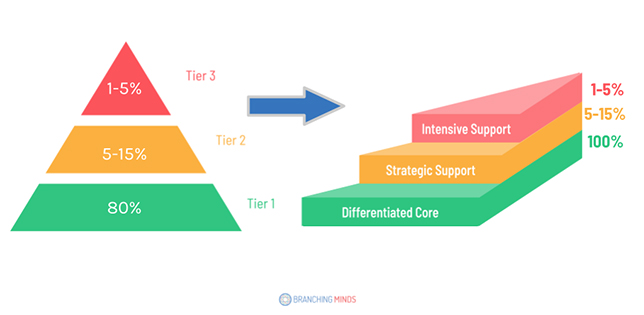How to Reframe MTSS to Help Close the Education Achievement Gap
The COVID-19 pandemic drastically worsened the educational achievement gap in this country, exacerbating many of the underlying systemic problems that contribute to inequities in learning. Longstanding and complicated problems like insufficient school funding, overwhelming class sizes and lack of access to early childhood education are all drivers of the widening education achievement gap, but there is another, often overlooked factor: a common misunderstanding of the Multi-Tiered System of Supports (MTSS) pyramid. A simple shift in how educators understand and implement MTSS can help close the achievement gap in their classrooms, schools, and districts.
What is MTSS?
MTSS is a framework increasingly used in schools to identify, triage, and provide appropriate levels of support that students need to achieve success. In this system, schools use collaboration, data, and evidence-based resources to provide equal opportunity for all learners to access grade-level content. MTSS addresses the needs of the whole student — academically, behaviorally, and socially-emotionally, and is widely recommended by education researchers to improve student outcomes and shrink equity gaps. As more schools seek ways to address inequities deepened by the pandemic, MTSS has become a reliable and popular pathway forward.
Traditionally, an MTSS model aims for an “80-15-5” approach to supporting students through tiered instruction. Yet, there is a common misunderstanding of this approach that is not only inhibiting schools from improving student outcomes but potentially even worsening them.
Let’s unpack what the 80-15-5 approach is supposed to mean. Essentially, it’s a way to identify which students need additional layers of support. The guidance is that for 80% of students, providing effective grade-level core instruction (the whole class first instruction teachers typically provide, also called Tier 1 Level Support) should be sufficient for them to achieve grade-level expectations.
Typically, for 15% of students, that core instruction will not be sufficient on its own, and those learners will require an additional level of support often provided in a small group setting and referred to as Tier 2 level support. For 5% of students, neither Tier 1 nor Tier 2 level support will be sufficient for them to achieve grade-level expectations and they will require an additional, individual, intensive Tier 3 level of support.
All Students Need Tier-1 Instruction, Some Need More
Inherently, there is nothing wrong with aiming for an 80-15-5 support approach. However, all too often, educators misunderstand this breakdown typically represented as a pyramid to mean that grade-level core instruction (or Tier 1) should not be provided to all students, but only to that 80%, while the remaining 20% of students are “placed” into tiers where they are only provided intervention or remedial instruction.
As a result of this misunderstanding, some students who are flagged as needing intervention only receive content deemed appropriate for their skill level, which is typically below their grade level. While well-intentioned, this “placement model” continually denies struggling learners access to grade-level content critical to their academic success and ultimately widens learning gaps. Furthermore, it misconstrues MTSS as a pathway of support from Tier 1 to 2 to 3, and then eventually a special education evaluation, rather than a continuous and cyclical support structure within general education.
Shifting the Pyramid Perspective
To address the issues with the 80-15-5 approach, Branching Minds, a provider of MTSS system-level solutions, released an updated version of the MTSS pyramid to place the emphasis of Tier 1 instruction on supporting all students. While it’s a simple adjustment of verbiage and visuals, it scratches at a deeply-rooted issue.
Tier 1 is core instruction, and core instruction must be delivered in a way that supports 100% of students to access grade-level content; Tier 2 and Tier 3 level support is additional support, to be layered on top of – never in lieu of – Tier 1.

Universal Tier-1 Instruction Reduces Inequities in Learning
In “Leading Equity-Based MTSS for All Students,” education researchers and practitioners Amy McCart and Dawn Miller write, “All roads (in MTSS) lead back to the universal support. If there is one lesson we’ve learned on our journey with MTSS over the last two decades, it is that if the first instruction isn’t strong (enough), we have missed the mark.”
Before we move into the next school year, now is the time to evaluate practices that we once thought were immovable in education and respond to our current reality so we can build a stronger education future for all students. Realigning our thoughts and actions around core instruction provides a best practice approach to addressing learning gaps with equity and fidelity. We can do this by clearing up this key misconception of who should receive grade-level core instruction and advocating for Tier 1 instruction for all students.
Resource: To create equitable Tier 1 instruction for all students and accelerate core instruction, teachers can apply these three power moves.
About the Author
Eva Dundas is the Chief Learning Officer of Branching Minds, where her mission is to bridge the gap between the science of learning and education practice. Dundas holds a Ph.D. in Developmental and Cognitive Psychology from Carnegie Mellon University, a M.Ed. in Mind, Brain, and Education from Harvard University, and a B.S. in Neuroscience from the University of Pittsburgh. Her research has been published in numerous academic journals.